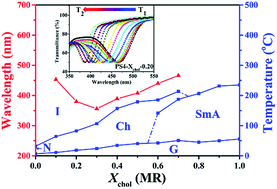Our official English website, www.x-mol.net, welcomes your feedback! (Note: you will need to create a separate account there.)
Influence of shorter backbone and cholesteric monomer percentage on the phase structures and thermal-optical properties of linear siloxane tetramers containing cholesterol and benzene methyl ether groups
RSC Advances ( IF 3.9 ) Pub Date : 2016-09-13 00:00:00 , DOI: 10.1039/c6ra17692e Wenhuan Yao 1, 2, 3, 4, 5 , Yanzi Gao 5, 6, 7, 8, 9 , Fasheng Li 5, 10, 11, 12 , Lanying Zhang 5, 6, 7, 8, 9 , Zhou Yang 1, 2, 3, 4, 5 , Huai Yang 1, 2, 3, 4, 5
RSC Advances ( IF 3.9 ) Pub Date : 2016-09-13 00:00:00 , DOI: 10.1039/c6ra17692e Wenhuan Yao 1, 2, 3, 4, 5 , Yanzi Gao 5, 6, 7, 8, 9 , Fasheng Li 5, 10, 11, 12 , Lanying Zhang 5, 6, 7, 8, 9 , Zhou Yang 1, 2, 3, 4, 5 , Huai Yang 1, 2, 3, 4, 5
Affiliation

|
A series of new linear polysiloxane tetramers containing cholesterol and benzene methyl ether groups as side chains was successfully synthesized via a typical hydrosilylation reaction. Their chemical structures were confirmed by 1H-NMR, FT-IR and thermogravimetric analysis (TGA). A combination of analysis methods such as differential scanning calorimetry (DSC), polarized optical microscopy (POM), and X-ray diffraction was carried out to systematically investigate their phase transition behaviours and phase structures. The results revealed that the mesophase structures of all the polymers were greatly dependent on the molar content of the chiral cholesteric unit (Xchol). Polymers with Xchol below 0.60 or over 0.70 could develop a stable cholesteric phase or smectic A phase, while both smectic A and cholesteric phases could be formed for polymers with Xchol between 0.60 and 0.70. Besides, polymers with Xchol below 0.60, which developed a cholesteric phase with sufficiently wide temperature ranges in the entire mesomorphic state (minimum over 50 °C and maximum over 130 °C), could also exhibit tunable selective reflection wavelengths between 470–560 nm upon heating and arbitrarily regulated glass transition temperatures between 0–40 °C. As a result, a thermochromism liquid crystalline material for temperature sensors was successfully obtained. Surprisingly, different from the results previously reported, an unusual phenomenon of the centre selective light reflection wavelength (λm) vs. Xchol, which decreased dramatically (blue shift) at first, then had a remarkable red shift with increasing Xchol, was first observed.
中文翻译:

较短的骨架和胆甾型单体百分比对含有胆固醇和苯甲基醚基的线性硅氧烷四聚物的相结构和热光学性质的影响
通过典型的氢化硅烷化反应成功地合成了一系列含有胆固醇和苯甲基醚基团作为侧链的新型线性聚硅氧烷四聚体。通过1 H-NMR,FT-IR和热重分析(TGA)确认了它们的化学结构。结合分析方法,如差示扫描量热法(DSC),偏振光学显微镜(POM)和X射线衍射,系统地研究了它们的相变行为和相结构。结果表明,所有聚合物的中间相结构在很大程度上取决于手性胆甾醇单元(X chol)的摩尔含量。含X胆甾醇的聚合物低于0.60或超过0.70可能会形成稳定的胆甾相或近晶A相,而X chol在0.60至0.70之间的聚合物可能会形成近晶A相和胆甾相。此外,含X胆甾醇的聚合物低于0.60时,在整个介晶状态下会形成胆甾醇相,并具有足够宽的温度范围(最低超过50°C,最高超过130°C),在加热和任意调节的玻璃下,其选择性反射波长也可能在470-560 nm之间可调转变温度在0–40°C之间。结果,成功获得了用于温度传感器的热致变色液晶材料。令人惊讶地,从先前报道的结果不同,中心选择性光反射波长的一个不寻常的现象(λ米)与X CHOL,这显着降低在第一(蓝移),则有随着显着的红移X CHOL,是首先观察。
更新日期:2016-09-13
中文翻译:

较短的骨架和胆甾型单体百分比对含有胆固醇和苯甲基醚基的线性硅氧烷四聚物的相结构和热光学性质的影响
通过典型的氢化硅烷化反应成功地合成了一系列含有胆固醇和苯甲基醚基团作为侧链的新型线性聚硅氧烷四聚体。通过1 H-NMR,FT-IR和热重分析(TGA)确认了它们的化学结构。结合分析方法,如差示扫描量热法(DSC),偏振光学显微镜(POM)和X射线衍射,系统地研究了它们的相变行为和相结构。结果表明,所有聚合物的中间相结构在很大程度上取决于手性胆甾醇单元(X chol)的摩尔含量。含X胆甾醇的聚合物低于0.60或超过0.70可能会形成稳定的胆甾相或近晶A相,而X chol在0.60至0.70之间的聚合物可能会形成近晶A相和胆甾相。此外,含X胆甾醇的聚合物低于0.60时,在整个介晶状态下会形成胆甾醇相,并具有足够宽的温度范围(最低超过50°C,最高超过130°C),在加热和任意调节的玻璃下,其选择性反射波长也可能在470-560 nm之间可调转变温度在0–40°C之间。结果,成功获得了用于温度传感器的热致变色液晶材料。令人惊讶地,从先前报道的结果不同,中心选择性光反射波长的一个不寻常的现象(λ米)与X CHOL,这显着降低在第一(蓝移),则有随着显着的红移X CHOL,是首先观察。








































 京公网安备 11010802027423号
京公网安备 11010802027423号